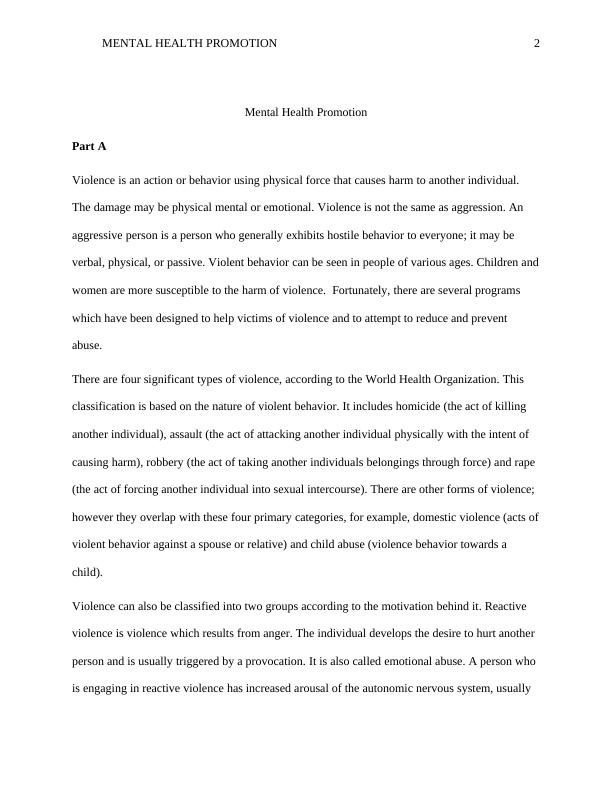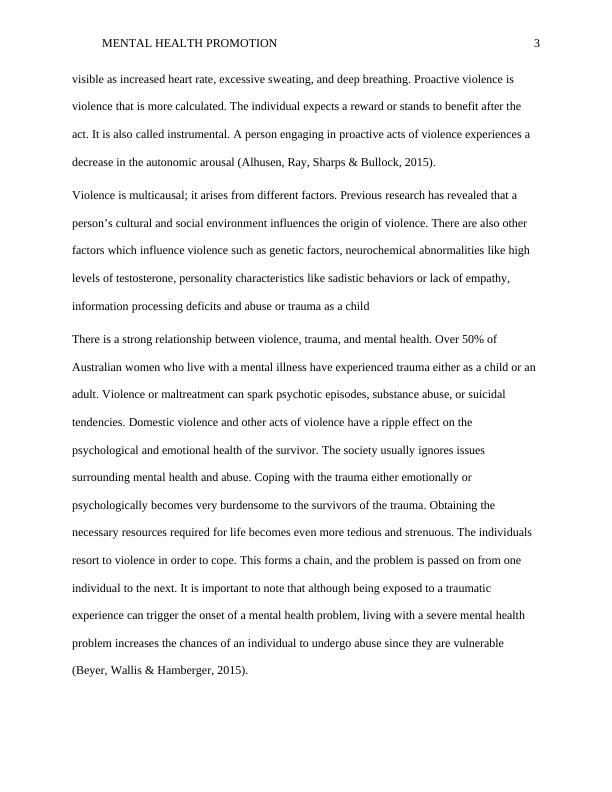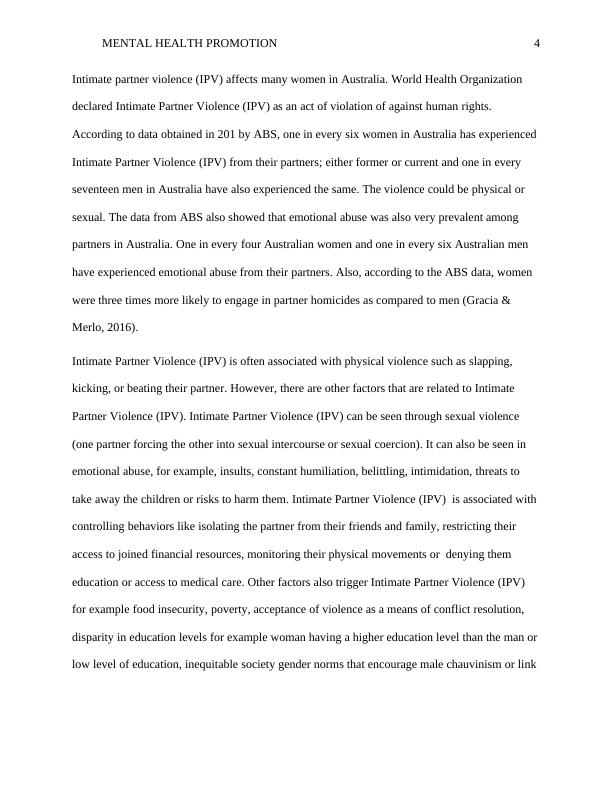Mental Health Promotion: Understanding and Preventing Intimate Partner Violence
Added on 2022-11-03
12 Pages3663 Words438 Views
Running head: MENTAL HEALTH PROMOTION 1
Mental health promotion
Student name
Student number
Date
Word count-2448
Mental health promotion
Student name
Student number
Date
Word count-2448

MENTAL HEALTH PROMOTION 2
Mental Health Promotion
Part A
Violence is an action or behavior using physical force that causes harm to another individual.
The damage may be physical mental or emotional. Violence is not the same as aggression. An
aggressive person is a person who generally exhibits hostile behavior to everyone; it may be
verbal, physical, or passive. Violent behavior can be seen in people of various ages. Children and
women are more susceptible to the harm of violence. Fortunately, there are several programs
which have been designed to help victims of violence and to attempt to reduce and prevent
abuse.
There are four significant types of violence, according to the World Health Organization. This
classification is based on the nature of violent behavior. It includes homicide (the act of killing
another individual), assault (the act of attacking another individual physically with the intent of
causing harm), robbery (the act of taking another individuals belongings through force) and rape
(the act of forcing another individual into sexual intercourse). There are other forms of violence;
however they overlap with these four primary categories, for example, domestic violence (acts of
violent behavior against a spouse or relative) and child abuse (violence behavior towards a
child).
Violence can also be classified into two groups according to the motivation behind it. Reactive
violence is violence which results from anger. The individual develops the desire to hurt another
person and is usually triggered by a provocation. It is also called emotional abuse. A person who
is engaging in reactive violence has increased arousal of the autonomic nervous system, usually
Mental Health Promotion
Part A
Violence is an action or behavior using physical force that causes harm to another individual.
The damage may be physical mental or emotional. Violence is not the same as aggression. An
aggressive person is a person who generally exhibits hostile behavior to everyone; it may be
verbal, physical, or passive. Violent behavior can be seen in people of various ages. Children and
women are more susceptible to the harm of violence. Fortunately, there are several programs
which have been designed to help victims of violence and to attempt to reduce and prevent
abuse.
There are four significant types of violence, according to the World Health Organization. This
classification is based on the nature of violent behavior. It includes homicide (the act of killing
another individual), assault (the act of attacking another individual physically with the intent of
causing harm), robbery (the act of taking another individuals belongings through force) and rape
(the act of forcing another individual into sexual intercourse). There are other forms of violence;
however they overlap with these four primary categories, for example, domestic violence (acts of
violent behavior against a spouse or relative) and child abuse (violence behavior towards a
child).
Violence can also be classified into two groups according to the motivation behind it. Reactive
violence is violence which results from anger. The individual develops the desire to hurt another
person and is usually triggered by a provocation. It is also called emotional abuse. A person who
is engaging in reactive violence has increased arousal of the autonomic nervous system, usually

MENTAL HEALTH PROMOTION 3
visible as increased heart rate, excessive sweating, and deep breathing. Proactive violence is
violence that is more calculated. The individual expects a reward or stands to benefit after the
act. It is also called instrumental. A person engaging in proactive acts of violence experiences a
decrease in the autonomic arousal (Alhusen, Ray, Sharps & Bullock, 2015).
Violence is multicausal; it arises from different factors. Previous research has revealed that a
person’s cultural and social environment influences the origin of violence. There are also other
factors which influence violence such as genetic factors, neurochemical abnormalities like high
levels of testosterone, personality characteristics like sadistic behaviors or lack of empathy,
information processing deficits and abuse or trauma as a child
There is a strong relationship between violence, trauma, and mental health. Over 50% of
Australian women who live with a mental illness have experienced trauma either as a child or an
adult. Violence or maltreatment can spark psychotic episodes, substance abuse, or suicidal
tendencies. Domestic violence and other acts of violence have a ripple effect on the
psychological and emotional health of the survivor. The society usually ignores issues
surrounding mental health and abuse. Coping with the trauma either emotionally or
psychologically becomes very burdensome to the survivors of the trauma. Obtaining the
necessary resources required for life becomes even more tedious and strenuous. The individuals
resort to violence in order to cope. This forms a chain, and the problem is passed on from one
individual to the next. It is important to note that although being exposed to a traumatic
experience can trigger the onset of a mental health problem, living with a severe mental health
problem increases the chances of an individual to undergo abuse since they are vulnerable
(Beyer, Wallis & Hamberger, 2015).
visible as increased heart rate, excessive sweating, and deep breathing. Proactive violence is
violence that is more calculated. The individual expects a reward or stands to benefit after the
act. It is also called instrumental. A person engaging in proactive acts of violence experiences a
decrease in the autonomic arousal (Alhusen, Ray, Sharps & Bullock, 2015).
Violence is multicausal; it arises from different factors. Previous research has revealed that a
person’s cultural and social environment influences the origin of violence. There are also other
factors which influence violence such as genetic factors, neurochemical abnormalities like high
levels of testosterone, personality characteristics like sadistic behaviors or lack of empathy,
information processing deficits and abuse or trauma as a child
There is a strong relationship between violence, trauma, and mental health. Over 50% of
Australian women who live with a mental illness have experienced trauma either as a child or an
adult. Violence or maltreatment can spark psychotic episodes, substance abuse, or suicidal
tendencies. Domestic violence and other acts of violence have a ripple effect on the
psychological and emotional health of the survivor. The society usually ignores issues
surrounding mental health and abuse. Coping with the trauma either emotionally or
psychologically becomes very burdensome to the survivors of the trauma. Obtaining the
necessary resources required for life becomes even more tedious and strenuous. The individuals
resort to violence in order to cope. This forms a chain, and the problem is passed on from one
individual to the next. It is important to note that although being exposed to a traumatic
experience can trigger the onset of a mental health problem, living with a severe mental health
problem increases the chances of an individual to undergo abuse since they are vulnerable
(Beyer, Wallis & Hamberger, 2015).

MENTAL HEALTH PROMOTION 4
Intimate partner violence (IPV) affects many women in Australia. World Health Organization
declared Intimate Partner Violence (IPV) as an act of violation of against human rights.
According to data obtained in 201 by ABS, one in every six women in Australia has experienced
Intimate Partner Violence (IPV) from their partners; either former or current and one in every
seventeen men in Australia have also experienced the same. The violence could be physical or
sexual. The data from ABS also showed that emotional abuse was also very prevalent among
partners in Australia. One in every four Australian women and one in every six Australian men
have experienced emotional abuse from their partners. Also, according to the ABS data, women
were three times more likely to engage in partner homicides as compared to men (Gracia &
Merlo, 2016).
Intimate Partner Violence (IPV) is often associated with physical violence such as slapping,
kicking, or beating their partner. However, there are other factors that are related to Intimate
Partner Violence (IPV). Intimate Partner Violence (IPV) can be seen through sexual violence
(one partner forcing the other into sexual intercourse or sexual coercion). It can also be seen in
emotional abuse, for example, insults, constant humiliation, belittling, intimidation, threats to
take away the children or risks to harm them. Intimate Partner Violence (IPV) is associated with
controlling behaviors like isolating the partner from their friends and family, restricting their
access to joined financial resources, monitoring their physical movements or denying them
education or access to medical care. Other factors also trigger Intimate Partner Violence (IPV)
for example food insecurity, poverty, acceptance of violence as a means of conflict resolution,
disparity in education levels for example woman having a higher education level than the man or
low level of education, inequitable society gender norms that encourage male chauvinism or link
Intimate partner violence (IPV) affects many women in Australia. World Health Organization
declared Intimate Partner Violence (IPV) as an act of violation of against human rights.
According to data obtained in 201 by ABS, one in every six women in Australia has experienced
Intimate Partner Violence (IPV) from their partners; either former or current and one in every
seventeen men in Australia have also experienced the same. The violence could be physical or
sexual. The data from ABS also showed that emotional abuse was also very prevalent among
partners in Australia. One in every four Australian women and one in every six Australian men
have experienced emotional abuse from their partners. Also, according to the ABS data, women
were three times more likely to engage in partner homicides as compared to men (Gracia &
Merlo, 2016).
Intimate Partner Violence (IPV) is often associated with physical violence such as slapping,
kicking, or beating their partner. However, there are other factors that are related to Intimate
Partner Violence (IPV). Intimate Partner Violence (IPV) can be seen through sexual violence
(one partner forcing the other into sexual intercourse or sexual coercion). It can also be seen in
emotional abuse, for example, insults, constant humiliation, belittling, intimidation, threats to
take away the children or risks to harm them. Intimate Partner Violence (IPV) is associated with
controlling behaviors like isolating the partner from their friends and family, restricting their
access to joined financial resources, monitoring their physical movements or denying them
education or access to medical care. Other factors also trigger Intimate Partner Violence (IPV)
for example food insecurity, poverty, acceptance of violence as a means of conflict resolution,
disparity in education levels for example woman having a higher education level than the man or
low level of education, inequitable society gender norms that encourage male chauvinism or link

End of preview
Want to access all the pages? Upload your documents or become a member.
Related Documents
General Aggression Modellg...
|18
|768
|99
Assignment on Child survivors of abuse PDFlg...
|9
|1478
|54
Mental Health Promotion: Preventing IPV and the Role of Nurseslg...
|13
|3381
|413
Effect of Domestic Violence on Children - (Doc)lg...
|26
|10242
|179
Nursing: Understanding Child Abuse, Youth Violence, and Sexual Assaultlg...
|4
|826
|460
Domestic Violence: A Public Health Issue in Australialg...
|11
|2975
|425
